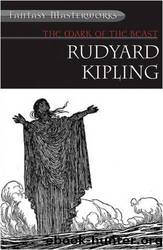The Mark of the Beast by Rudyard Kipling

Author:Rudyard Kipling [Kipling, Rudyard]
Language: eng
Format: epub
ISBN: 9780486143248
Barnesnoble:
Publisher: Dover Publications
Published: 2012-12-20T05:00:00+00:00
THE TOMB OF HIS ANCESTORS
Some people will tell you that if there were but a single loaf of bread in all India it would be divided equally between the Plowdens, the Trevors, the Beadons, and the Rivett-Carnacs. That is only one way of saying that certain families serve India generation after generation as dolphins follow in line across the open sea.
Let us take a small and obscure case. There has been at least one representative of the Devonshire Chinns in or near Central India since the days of Lieutenant-Fireworker Humphrey Chinn, of the Bombay European Regiment, who assisted at the capture of Seringapatam in 1799. Alfred Ellis Chinn, Humphreyâs younger brother, commanded a regiment of Bombay Grenadiers from 1804 to 1813, when he saw some mixed fighting; and in 1834 John Chinn of the same family-we will call him John Chinn the First â came to light as a levelheaded administrator in time of trouble at a place called Mundesur. He died young, but left his mark on the new country, and the Honourable Board of Directors of the Honourable the East India Company embodied his virtues in a stately resolution, and paid for the expenses of his tomb among the Satpura hills.
He was succeeded by his son, Lionel Chinn, who left the little old Devonshire home just in time to be severely wounded in the Mutiny. He spent his working life within a hundred and fifty miles of John Chinnâs grave, and rose to the command of a regiment of small, wild hill-men, most of whom had known his father. His son John was born in the small thatched-roofed, mud-walled cantonment, which is even to-day eighty miles from the nearest railway, in the heart of a scrubby, tigerishcountry. Colonel Lionel Chinn served thirty years and retired. In the Canal his steamer passed the outward-bound troopship, carrying his son eastward to the family duties.
The Chinns are luckier than most folk, because they know exactly what they must do. A clever Chinn passes for the Bombay Civil Service, and gets away to Central India, where everybody is glad to see him. A dull Chinn enters the Police Department of the Woods and Forests, and sooner or later, he, too, appears in Central India, and that is what gave rise to the saying âCentral India is inhabited by Bhils, Mairs, and Chinns, all very much alike.â The breed is small-boned, dark, and silent, and the stupidest of them are good shots. John Chinn the Second was rather clever, but as the eldest son he entered the army, according to Chinn tradition. His duty was to abide in his fatherâs regiment, for the term of his natural life, though the corps was one which most men would have paid heavily to avoid. They were irregulars, small, dark, and blackish, clothed in rifle-green with black-leather trimmings; and friends called them the âWuddarsâ, which means a race of low-caste people who dig up rats to eat. But the Wuddars did not resent it. They were
Download
This site does not store any files on its server. We only index and link to content provided by other sites. Please contact the content providers to delete copyright contents if any and email us, we'll remove relevant links or contents immediately.
The Tales of Beedle the Bard by J.k.rowling (eng)(2365)
Fable: A Novel by Adrienne Young(1143)
The Ickabog by J. K. Rowling(1127)
Ghost Drum: Book 1 of The Ghost World Sequence by Susan Price(1116)
Fantastic Beasts and Where to Find Them: Illustrated Edition by J. K. Rowling & Newt Scamander(995)
The Silvered Serpents by Roshani Chokshi(846)
Wings of Fire Graphic Novel #4 by Tui T. Sutherland(691)
The Lion King by Disney Book Group(680)
Champion: The Graphic Novel (Legend) by Marie Lu(646)
Magnus Chase The Sword of Summer by Rick Riordan(641)
The Tombs of Atuan by Ursula K LeGuin(638)
Sweet & Bitter Magic by Adrienne Tooley(616)
The Hero by Amelia Shea(588)
The Alchemyst (The Secrets of the Immortal Nicholas Flamel Book 1) by Michael Scott(573)
Heroes of Olympus Book 1 - The Lost Hero by Rick Riordan(499)
Tales From Earthsea by Ursula K. LeGuin(471)
Trouble in the Stars by Sarah Prineas(463)
Grandparents' Bag of Stories by Sudha Murty(436)
Mary Pope Osborne - Magic Tree House 18 by Buffalo Before Breakfast(435)
